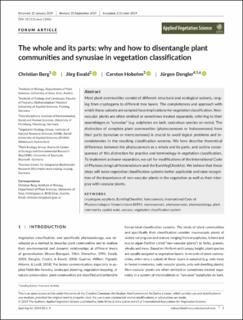Please use this identifier to cite or link to this item:
https://doi.org/10.21256/zhaw-18486Full metadata record
| DC Field | Value | Language |
|---|---|---|
| dc.contributor.author | Berg, Christian | - |
| dc.contributor.author | Ewald, Jörg | - |
| dc.contributor.author | Hobohm, Carsten | - |
| dc.contributor.author | Dengler, Jürgen | - |
| dc.date.accessioned | 2019-10-18T09:11:37Z | - |
| dc.date.available | 2019-10-18T09:11:37Z | - |
| dc.date.issued | 2020 | - |
| dc.identifier.issn | 1402-2001 | de_CH |
| dc.identifier.issn | 1654-109X | de_CH |
| dc.identifier.uri | https://digitalcollection.zhaw.ch/handle/11475/18486 | - |
| dc.description.abstract | Most plant communities consist of different structural and ecological subsets, ranging from cryptogams to different tree layers. The completeness and approach with which these subsets are sampled have implications for vegetation classification. Non‐vascular plants are often omitted or sometimes treated separately, referring to their assemblages as “synusiae” (e.g. epiphytes on bark, saxicolous species on rocks). The distinction of complete plant communities (phytocoenoses or holocoenoses) from their parts (synusiae or merocoenoses) is crucial to avoid logical problems and inconsistencies of the resulting classification systems. We here describe theoretical differences between the phytocoenosis as a whole and its parts, and outline consequences of this distinction for practise and terminology in vegetation classification. To implement a clearer separation, we call for modifications of the International Code of Phytosociological Nomenclature and the EuroVegChecklist. We believe that these steps will make vegetation classification systems better applicable and raise the recognition of the importance of non‐vascular plants in the vegetation as well as their interplay with vascular plants. | de_CH |
| dc.language.iso | en | de_CH |
| dc.publisher | Wiley | de_CH |
| dc.relation.ispartof | Applied Vegetation Science | de_CH |
| dc.rights | https://creativecommons.org/licenses/by-nc-nd/4.0/ | de_CH |
| dc.subject | Cryptogam | de_CH |
| dc.subject | Epiphyte | de_CH |
| dc.subject | EuroVegChecklist | de_CH |
| dc.subject | Holocoenosis | de_CH |
| dc.subject | International Code of Phytosociological Nomenclature (ICPN) | de_CH |
| dc.subject | Merocoenosis | de_CH |
| dc.subject | Phytocoenosis | de_CH |
| dc.subject | Phytosociology | de_CH |
| dc.subject | Plant community | de_CH |
| dc.subject | Spatial scale | de_CH |
| dc.subject | Synusia | de_CH |
| dc.subject | Vegetation classification system (VCS) | de_CH |
| dc.subject.ddc | 580: Pflanzen (Botanik) | de_CH |
| dc.title | The whole and its parts : why and how to disentangle plant communities and synusiae in vegetation classification | de_CH |
| dc.type | Beitrag in wissenschaftlicher Zeitschrift | de_CH |
| dcterms.type | Text | de_CH |
| zhaw.departement | Life Sciences und Facility Management | de_CH |
| zhaw.organisationalunit | Institut für Umwelt und Natürliche Ressourcen (IUNR) | de_CH |
| dc.identifier.doi | 10.1111/avsc.12461 | de_CH |
| dc.identifier.doi | 10.21256/zhaw-18486 | - |
| zhaw.funding.eu | No | de_CH |
| zhaw.issue | 1 | de_CH |
| zhaw.originated.zhaw | Yes | de_CH |
| zhaw.pages.end | 135 | de_CH |
| zhaw.pages.start | 127 | de_CH |
| zhaw.publication.status | publishedVersion | de_CH |
| zhaw.volume | 23 | de_CH |
| zhaw.publication.review | Peer review (Publikation) | de_CH |
| zhaw.author.additional | No | de_CH |
| Appears in collections: | Publikationen Life Sciences und Facility Management | |
Files in This Item:
| File | Description | Size | Format | |
|---|---|---|---|---|
| Berg_et_al-2019-Applied_Vegetation_Science.pdf | 696.78 kB | Adobe PDF |  View/Open |
Show simple item record
Berg, C., Ewald, J., Hobohm, C., & Dengler, J. (2020). The whole and its parts : why and how to disentangle plant communities and synusiae in vegetation classification. Applied Vegetation Science, 23(1), 127–135. https://doi.org/10.1111/avsc.12461
Berg, C. et al. (2020) ‘The whole and its parts : why and how to disentangle plant communities and synusiae in vegetation classification’, Applied Vegetation Science, 23(1), pp. 127–135. Available at: https://doi.org/10.1111/avsc.12461.
C. Berg, J. Ewald, C. Hobohm, and J. Dengler, “The whole and its parts : why and how to disentangle plant communities and synusiae in vegetation classification,” Applied Vegetation Science, vol. 23, no. 1, pp. 127–135, 2020, doi: 10.1111/avsc.12461.
BERG, Christian, Jörg EWALD, Carsten HOBOHM und Jürgen DENGLER, 2020. The whole and its parts : why and how to disentangle plant communities and synusiae in vegetation classification. Applied Vegetation Science. 2020. Bd. 23, Nr. 1, S. 127–135. DOI 10.1111/avsc.12461
Berg, Christian, Jörg Ewald, Carsten Hobohm, and Jürgen Dengler. 2020. “The Whole and Its Parts : Why and How to Disentangle Plant Communities and Synusiae in Vegetation Classification.” Applied Vegetation Science 23 (1): 127–35. https://doi.org/10.1111/avsc.12461.
Berg, Christian, et al. “The Whole and Its Parts : Why and How to Disentangle Plant Communities and Synusiae in Vegetation Classification.” Applied Vegetation Science, vol. 23, no. 1, 2020, pp. 127–35, https://doi.org/10.1111/avsc.12461.
Items in DSpace are protected by copyright, with all rights reserved, unless otherwise indicated.